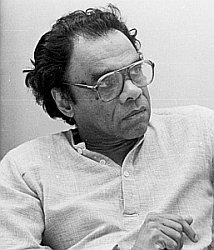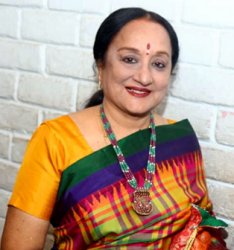
|   |

|   |
Poetry in Dance July 15, 2013 Most of our dance repertoire is poetry in song. We seldom get to read them just for their poetic beauty .We read them only when we are researching new texts for dance. Language skills are needed for this exercise. Poems when set to suitable tunes should inspire lyrical dance. 
A.K. Ramanujan
When I first encountered some lovely poems from ancient Tamil translated into poetic English I was excited enough to make Girish Karnad read some as I danced to the melodies of a sitar under a starlit sky in the Cholamandal artists village near Chennai. This was way back in 1976 and the book of translations was the famous Interior Landscape by A.K. Ramanujan. The last time I met him was in Hyderabad airport. A genial and unassuming man, he told me, "I am coming out with something of particular interest to you. That book is When God is Customer." I found his translations of many of my padams delightful and used them often to introduce my dance. Instead of the usual introductions, I just read out the poems and needless to say it was more than effective. Bhagirati, a theatre person and friend read some of them when I premiered an entire evening of padams titled HRDAYA VILAPAM. I think we enjoyed the evening as much as the audience. How do dancers relate to poetry? Is the intensity of the poet, his passion, his imagination explorable? Do they use all their dancing resources to create lyrical visual beauty? Not all dancers can boast of being linguists. In fact, most are handicapped by the fact that they cannot relate to any Indian language, let alone poetry in chaste Telugu, Sanskrit or Tamil. A lot is lost in translation. Poems which can be danced have beauty beyond language. This is what I discover every time I dance a padam. No song is done and finished for me. I keep discovering new meaning, new subtleties and new emotions every now and then. And I sigh....why did I not do this before? Yet the freshness of approach makes the re-visiting of songs worthwhile. My singers know that I am doing something different each time. They enjoy these surprises, thank God! Why are padams sung in a slow tempo, many ask. There are many answers to this. A singing tradition is the most obvious. Why was such a challenging tempo established? Singing to the tisra triputa tala is no mean task. To hold each note in friendly captivity is the task of the singer. Many do not understand the full import of the phrase RAGA BHAVA. Establishing that is the ultimate aim of singing a padam in slow tempo. In dance, this oneness of melody and meaning, tune and poem, is so subtle that only a lot of experience in music and dance can produce that magical moment of realized emotion. We use banal phrases such as poetry in motion but when it comes to actual movement and poetry we rarely see such a mingling which makes us see the music. For, after all, the music of padams is not abstract melody but poetry set to the most subtle musical nuances. Often, one sees students of padams analyzing the Nayika or heroine of a padam. Well, good for them that they do not get confused with the types of heroines. But is that all one needs to make the padam come alive? Are heroines merely women subjected to classification? Did the poets break into song with a list of Nayikas and their definitions in their hands? The genius of those pundits lies in spontaneous outpouring of passion. They wrote hymns of drowning in devotion. Sometimes even the carnal quietly mingles with the mystic devotion directed to their favourite gods. When Annamayya speaks of the sensuous goddess and the powerful god who is the only one who can please her, he makes a clear statement of faith in the physical beauty of love experienced by even the celestials! Here classifications simply don't count. A combination of body posture, movement of limbs and careful yet spontaneous use of suitable gestures can make the poetry of padams come alive in a lovely display of body language. We have useful tools, which by constant use can be made to look spontaneous and communicative. The gestures we use can say a lot as can our facial expressions. How does a dancer emote while thinking of the poetry she is expressing? The meaning and the underlying ideas are supposed to unfold like a lotus at sunrise. Often the hurried statement of sringara as a dancer tackles a beautiful Kshetragna poem leaves the audience cold. They exclaim, albeit silently: Oh no, not again this pining, or Oh no, too much of mush...! Let us not forget that they may not be connoisseurs of the language. It is up to the dancer to build up an interest in poetic ideas and express them with restraint and power. That sounds paradoxical. But that is the beauty of dance and poetry! There is power and passion in subtle suggestive gestures and expressions. My Guru used to say: Standing still can be appreciated only when it is preceded and followed by elegantly crafted movements which blend with Bhava and Raga. That is the secret of poetry in dance!  Lakshmi Vishwanathan, a prime disciple of Guru Kanjeevaram Elappa Pillai, is an exponent of the Thanjavur style of Bharatanatyam. She is also a trained vocalist. She is the author of several acclaimed books: Bharatanatyam - the Tamil Heritage, Kunjamma - Ode to a Nightingale, Kapaleeswara Temple, Women of Pride -The Devadasi Heritage. Her film 'The Poetry of Dance' was commissioned by the Festival of India. The Mamallapuram Dance Festival started in 1991 was Lakshmi's brainchild. She has served on several arts committees. She has served as Vice President of Music Academy (Chennai) and is a member of South Zone Cultural Centre. Comments Very well written and said ...as always, Lakshmi akka...enjoyed reading it. - Roja Kannan (Aug 4, 2013) I agree with the article. I spend a lot of time in India. Since my origin is Italian, the skill of knowing Hindi and Urdu has allowed me to enter in the essence of poetry. Thanks for this article and blog - Rosella Fanelli (Kathak dancer / teacher) July 16, 2013 Post your comments Pl provide your name and email id along with your comment. All appropriate comments posted with name and email id in the blog will also be featured in the site. |